
The Definition of Potash
Potash refers to a group of compounds containing potassium, such as potassium sulfate (K2SO4), potassium-magnesium sulfate (K2SO4-MgSO4), potassium nitrate (KNO3), potassium carbonate (K2CO3), potassium oxide (K2O), and potassium chloride (KCl).
Primarily utilized in fertilizer manufacturing, potash is essential for crop growth worldwide.
The term “potash” originates from the Dutch word “potaschen,” which translates to “pot ashes.”
Insights into Potash
Potash, in the form of a water-soluble potassium salt, is either mined or manufactured. Traditionally, it was obtained by leaching wood ashes in water and then evaporating the liquid to obtain a white residue known as potash.
This residue continues to play a vital role in fertilizer, soap, glass, and ceramics production.
Although potassium is abundant in the earth’s crust, potash needs refining before use. Its historical applications date back to 500 A.D., with the emergence of industries like glassmaking and soap production. The American potash industry evolved in the 18th and 19th centuries when settlers repurposed burnt wood ashes for commercial uses.
Pearl ash, akin to potash, is derived by burning cream of tartar and yields a more refined version of the substance, potassium carbonate.
Potash Trading Overview
Utilized as a fertilizer due to its water-soluble potassium content, potash enhances crop quality, yield, and other essential characteristics.
Main crops reliant on potash include corn, rice, wheat, and cotton. Potash, with types like potassium chloride (KCl) and potassium sulfate (SOP), remains irreplaceable in agricultural practices.
Market-wise, potash holds significant value, with the vast majority serving as fertilizer. Notably, Canada stands as a major supplier of potash to the United States.
Investors can engage in potash trading through established companies like Potash Corp. of Saskatchewan (POT), Agrium (AGU), and Mosaic (MOS) listed on the New York Stock Exchange (NYSE).
Potash Reserves and Production Insights
Potash deposits trace back to ancient shallow sea beds, where potassium and sodium chloride mixtures settled as water receded. Presently, countries like Belarus, Canada, China, Germany, Israel, Jordan, and Russia account for most of the world’s potash output.
The leading potash production region is Eastern Europe; however, Canada boasts the largest reserves globally. In the U.S., New Mexico and Utah contribute to potash production.
Various methods are employed in potash production, with the evaporation and dissolution mining techniques being predominant.







